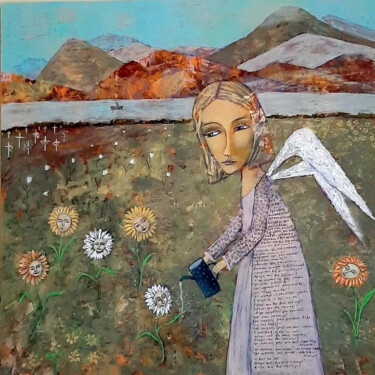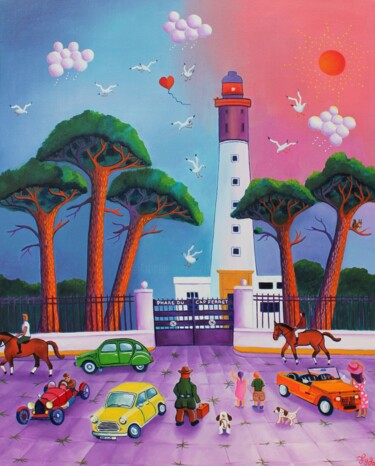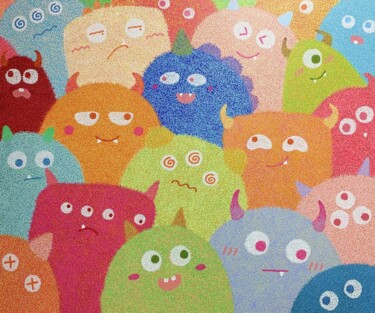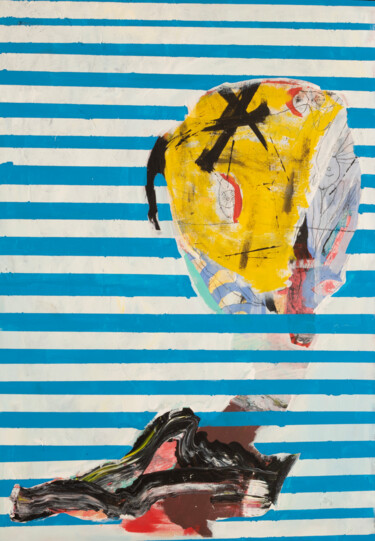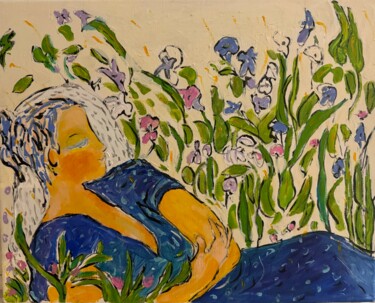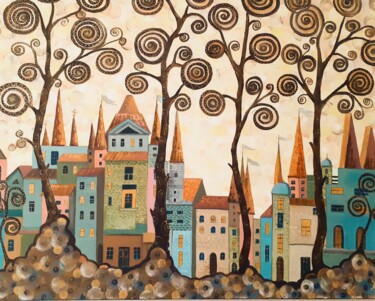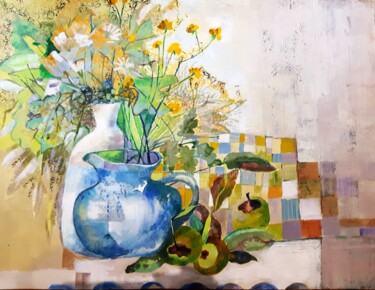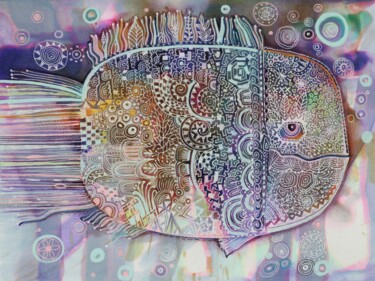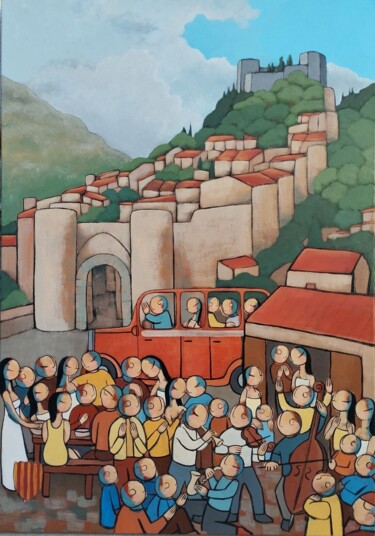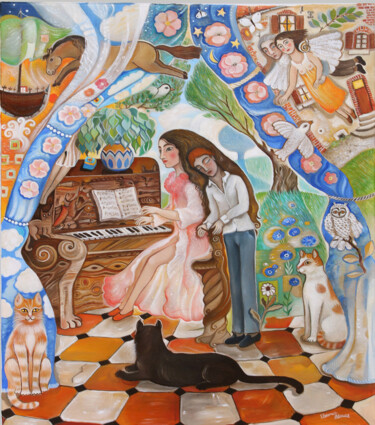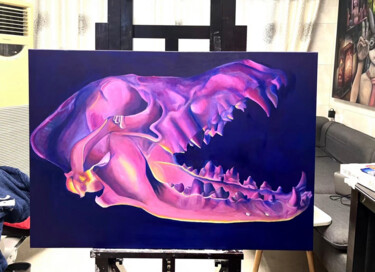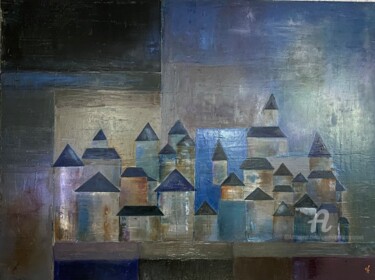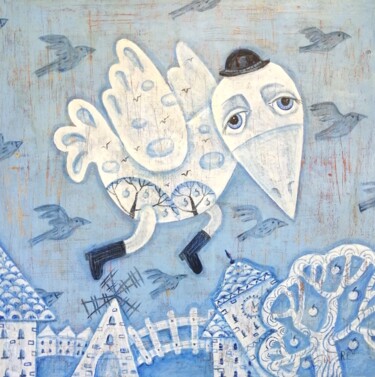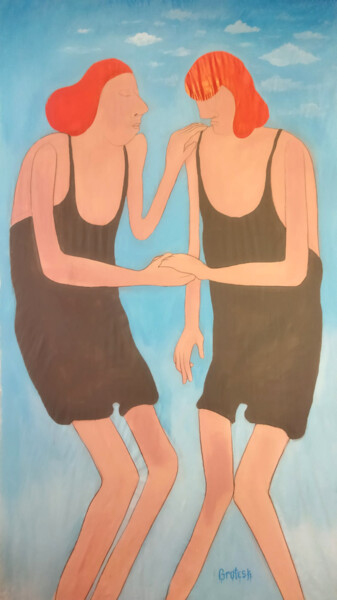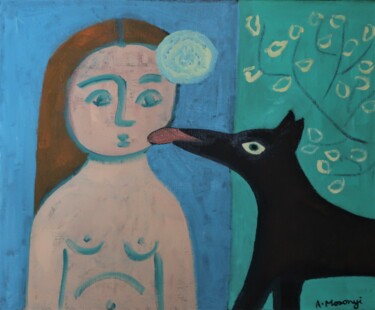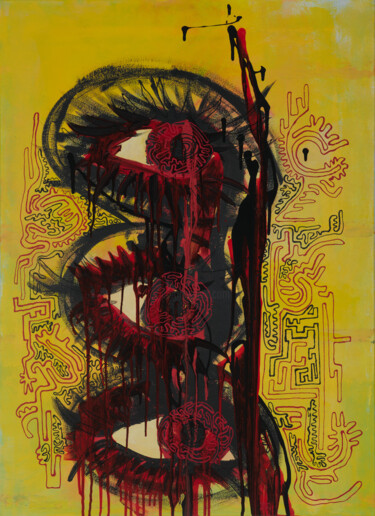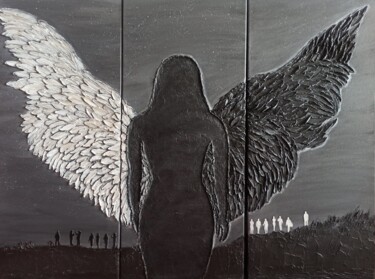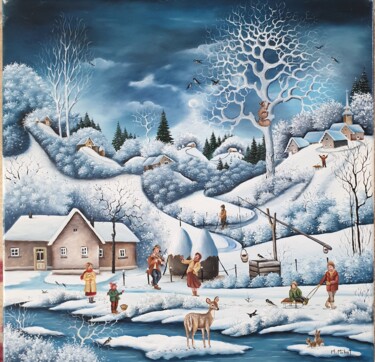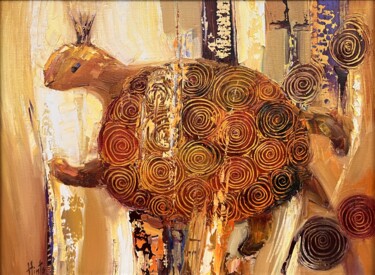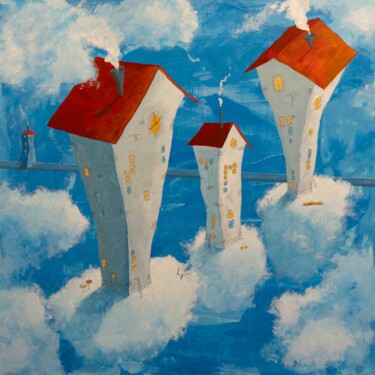617 Tableaux de peintures originales à vendre:
Comment définir style Art naïf ?
What is a Naive painting?
Naive painting is a style of art that was started by artists like Henri Rousseau who didn't know much about art. Most of the time, naive art is defined as visual art made by someone who hasn't had the training and education that a professional artist does. When a professional artist tries to copy this style, it is often called "primitivism."
What are the characteristics of Naive painting?
Naive art is usually defined as visual art made by someone who doesn't have the formal training and education that a professional artist does (in anatomy, art history, technique, perspective, ways of seeing). When a trained artist tries to copy this style, it is sometimes called primitivism, pseudo-naive art, or faux naive art.
Unlike folk art, naive art doesn't have to come from a specific popular cultural context or tradition. In fact, at least in advanced economies and since the Printing Revolution, it's impossible not to know about the local fine art tradition, which has spread through popular prints and other media. Naive artists know about "fine art" conventions like graphical perspective and compositional conventions, but they can't or don't use them to their full potential. Outsider art (also called "art brut"), on the other hand, refers to works that come from a similar background but have little to do with the mainstream art world.
Naive art is known for being simple and honest like a child, and this is why it is often copied. These kinds of paintings usually have a flat style of drawing and a simple way of showing depth. Henri Rousseau, a French Post-Impressionist who lived from 1844 to 1910 and was discovered by Pablo Picasso, was one of the most important painters of "naive art."
There has been some disagreement about what the term means and where it "ends" with other terms like folk art and outsider art. Naive art is usually used to describe works of fine art made by self-taught artists, like paintings and sculptures. Folk art, on the other hand, refers to things that can be used in everyday life. But this difference has been argued about. [6] "Provincial" is another word that can be used, especially for paintings and buildings. It is mostly used to describe work by artists who have had some traditional training but whose work falls short of metropolitan or court standards by accident.
By what do naive paintings stand out?
People often think of naive art as art made by someone who hasn't had any formal training or a degree, or hasn't had much. Before the 20th century, this was true, but now there are schools for naive art. Naive art is now a fully recognized type of art that can be seen in galleries all over the world.
The features of naive art don't fit well with the formal aspects of painting, especially when the three rules of perspective aren't followed (as described by the Progressive Painters of the Renaissance):
-Objects get smaller as you get farther away,
-Colors become less clear as you get farther away;
-Details become less clear as you get farther away.
Here are the results:
-Geometrically wrong effects of perspective (awkward parts of the works, like how children's drawings or paintings from the Middle Ages look, but that's where the comparison ends);
-Effects of perspective that aren't quite right. Strong use of pattern, unrefined color on all the plans of the composition, without enfeeblement in the background;
-Equal attention to details, including those in the background that should be shaded off.
People say that naive art is easy to spot because it is not complicated. It has become so popular and well-known, though, that many examples could be called "pseudo-naive." "Pseudo naive" or "faux naive" art is the work of an artist who is more imitative or self-conscious and whose work looks more copied than original. "Naive" art is the work of an artist who did not go to art school or academy, like Henri Rousseau or Alfred Wallis.
Since Autodidactism has become more popular as a way to learn in modern times, strict naiveté is not likely to be found in modern artists. Living artists don't always like naive categorizations, but this is likely to change as more dignifying signals become known. There are now museums for naive art in Kecskemét, Hungary; Kovaica, Serbia; Riga, Latvia; Jaen, Spain; Rio de Janeiro, Brazil; Vicq, France; and Paris. Gary Bunt, Lyle Carbajal, Gabe Langholtz, Gigi Mills, Barbara Olsen, Paine Proffitt, and Alain Thomas are all English-speaking living artists who admit to having a naive style.
"Primitive art" is another term that people who haven't studied art often use to describe it. Historically, though, it has been used more to describe art from cultures that Western academia has deemed "primitive" socially or technologically, like Native American, sub-Saharan African, and Pacific Island art (see Tribal art). This is different from the "primitive"-inspired, self-aware movement called "primitivism." Folk art is another term that is similar to naive art but not the same thing.
There are also the terms "navism" and "primitivism," which are usually used to describe professional painters who use naive art as their style (like Paul Gauguin, Mikhail Larionov, Paul Klee).
What is the history of the Naive movement?
No one knows exactly when the first naive artists started making art, but from the very beginning of art to the time of the "Modern Classic," naive artists have left behind clear signs of their creative work. At the very least, naive art has been "official" in the history of 20th-century art since 1912, when an almanac called Der Blaue Reiter was published. Wassily Kandinsky and Franz Marc, who made the almanac, showed six copies of Henri Rousseau's paintings and talked about how they were different from other pictures. Most experts agree, though, that naive art was "discovered" in 1885, when the painter Paul Signac learned about Henri Rousseau's skills and started putting on shows of his work in some of the best galleries in Paris.
The Sacred Heart painters
Wilhelm Uhde, a German art collector and critic, is known for being the main person in charge of the first Naive Art show, which took place in Paris in 1928. Henri Rousseau, André Bauchant, Camille Bombois, Séraphine Louis, and Louis Vivin all took part. Together, they are known as the Sacred Heart painters.
Earth Group
The Earth Group (Grupa Zemlja) was a group of artists, architects, and thinkers from Croatia who lived and worked in Zagreb from 1929 to 1935. The group was Marxist and was partly based on "Neue Sachlichkeit,"[19] which led to more stylized forms and the start of Naive painting. In the group were painters Krsto Hegedui, Edo Kovaevi, Omer Mujadi, Kamilo Ruika, Ivan Tabakovi, and Oton Postrunik, sculptors Antun Augustini and Frano Krini, and the architect Drago Ibler. The Earth group tried to figure out how to solve social problems. Their program stressed the importance of creative freedom and was against blindly copying styles from other countries. They didn't want to make art just for the sake of art. Instead, they thought it should reflect the real world and the needs of the modern community. The government of the time was getting more and more upset by what was going on at the group's exhibitions, so in 1935, the group was banned.
Hlebine School
From about 1930 on, this term was used to describe naive Croatian painters who worked in or around the village of Hlebine, which is near the border with Hungary. At this time, the village was just "a few muddy, winding streets and one-story houses," according to the World Encyclopedia of Naive Art (1984). However, it produced such a great crop of artists that it became almost synonymous with Yugoslav naive painting.
Hlebine is a small, beautiful town in the north of Croatia. In the 1920s, a group of self-taught peasants started to paint in a way that was different and even a little bit revolutionary. Leading intellectuals of the time, like the poet Antun Gustav Mato and Miroslav Krlea, the most famous name in Croatian literature, pushed for this. They wanted a unique national style of art that was not influenced by the West. Krsto Hegedui, a well-known artist from Hlebine, took these ideas and used them to start the Hlebine School of Art in 1930. He did this to find "rural artistic expression" on a national level.
Ivan Generali was the first master of the Hlebine School. He was also the first artist to create a unique style and reach a high level of art. After the Second World War, the next generation of Hlebine painters focused more on stylized, made-up pictures of life in the country. Generali stayed the most important person and helped other artists, including his son Josip Generali, get started. With the 1952 Venice Biennale and shows in Brazil and Belgium, the Hlebine school became known all over the world.
Some of the best known naive artists are Dragan Gaži, Ivan Generalić, Josip Generalić, Krsto Hegedušić, Mijo Kovačić, Ivan Lacković-Croata, Franjo Mraz, Ivan Večenaj and Mirko Virius.
What are some famous Naive paintings?
Naive art is made up of simple, childlike techniques and ideas. Because of this, modernists who don't like what they see as the fake sophistication of work made in the traditional system have praised it. Henri Rousseau is the best-known naive artist working today, so we'll start with one of his works.
The Dream (1910) by Henri Rousseau
The young girl has been taken to a jungle, where a local musician plays a brass instrument and sings to her. Yadwigha, who is half hidden by the jungle's shadows, reaches out to the musician while looking out over a beautiful view of jungle greenery with lotus petals, parrots, monkeys, an elephant, two lions, and a snake. The snake coming toward the scene in the lower right corner of the picture makes me think of the Garden of Eden. A pink snake moves through the bushes. Its shape, which is like a snake, looks like a woman's legs and hips.
In this piece of art, a naked model is sitting on a sofa, which brings together the familiar and the strange. The painting "The Dream" shows why the Surrealists liked Rousseau's work. It has amazing attention to detail, bright colors, and a strange mix of images.
At least 22 different shades of green were used to paint the jungle plants. Poet and art critic Guillaume Apollinaire was blown away by the work. "The painting is absolutely gorgeous!" he exclaimed. I don't think anyone will laugh this year."
This picture looks like a dream because the only thing in it is a naked woman lying on a sofa in the tropics. But it's not clear if the art shows Yadwigha's dream or Rousseau's. But one of the best things about the picture is how open it is to different interpretations. Rousseau's trips to the natural history museum and the Jardin des Plantes in Paris gave him ideas for this piece, which has a lush jungle, wild animals, and a mysterious horn player. "When I'm in these hothouses and see strange plants from other places, it feels like I'm entering a dream," the artist said of his visits.
Death ship (1942) by Alfred Wallis
The main idea behind Alfred Wallis's Death Ship is a huge black ship with dark gray steam billowing from it. Five sailors in black suits and caps can be seen as the ship moves over icy white water. This picture, which has a good name, is a great example of the kind of work Wallis did in his later years. They show how sad the artist was feeling at the time.
Wallis made these paintings while he was alone and his eyesight was getting worse and his mind was getting worse. No one knows for sure when Wallis finished making these last changes. They were made either while Wallis was living in the Madron poorhouse or just before he was sent there, which was something he had been afraid of for a long time. Death Ship disproves the idea that Wallis couldn't use deep and complicated symbolism in his work because he was a "naive" artist. The ship is a sign of death and destruction, which is more of a metaphor than a literal representation of the things Wallis paints. It is a mix of the feelings Wallis had when he was at sea and when he was near the coast of St. Ives.
The Broken Column (1944) by Frida Kahlo
After she was badly hurt in a car accident when she was 18, most of Frida Kahlo's self-portraits are about her physical and mental pain. As her health got worse, this theme came back and got much stronger as her life came to an end. Her graphic pictures of herself in pain show how hard it was for her to deal with physical problems and pain. "The Broken Column," a painting by Kahlo, was made soon after she had surgery on her back.
This was just one of many times she had to go to the doctor to fix problems caused by an injury she had in the past. Kahlo had to wear a steel corset while painting, which was different from the plaster casts she had worn before. In the picture, Kahlo is standing in a broken, empty place that looks like it has been through as much trouble and tragedy as she has. Due to a deep, jagged crack that runs the length of her almost-naked body, her spine looks like a broken Ionic stone column. Her spinal column looks like it's about to break, especially at the bottom. Nails of different sizes go through her whole body and face, making her pain even worse. She has a lot of tears running down her cheeks.
Kahlo painted herself naked at first, except for the medical support girdle she wears. Then she added a white covering that looks like it came from a hospital to cover her bottom half. Her breasts are showing, and even though her body has been cut up, her sensuality shines through. The way nails and sheets are shown also has strong echoes of the Christian symbol of martyrdom. Even though she is in pain, Kahlo's face shows that she is strong and will not give up. Even though her body has been hurt and tortured, it is clear that her spirit has not been hurt.
This is the end of our look at Naive art, a style that looks simple and childlike. This word is used to describe paintings made in cultures that are more or less advanced but don't have the traditional skills to draw things. The colors are bright and not natural, the view isn't scientific, and the meaning is literal or childish.
Vous cherchez des Peintures originales à vendre ?
Explorez tous les styles et toutes les techniques de peintures : peintures contemporaines, street-art, art abstrait, art figuratif, paysages, portraits, natures mortes, nus, aquarelle, peinture à l’huile, peinture acrylique … Artmajeur s’adresse à toutes les sensibilités artistiques et célèbre la beauté à vos côtés depuis 20 ans avec plus de 2 millions d’œuvres d'art contemporaines à découvrir... ou à acquérir ! La référence mondiale en matière de peintures contemporaines. Découvrez des œuvres d’artistes contemporains du monde entier pour décorer votre intérieur avec classe ! Simple amateur d’Art ou collectionneur confirmé ? Trouvez la toile ou le tableau coup de cœur qui saura véritablement mettre en valeur votre décoration. Artmajeur vous propose des œuvres originales, des éditions limitées et des impressions d'art par les meilleurs artistes contemporains du monde. Sur Artmajeur, les peintures sont sélectionnées par des passionnés et experts du marché de l'art. Nous sélectionnons pour vous les œuvres originales de peintres tendances, primés et reconnus ainsi que les nouvelles valeurs montantes dans le domaine de l’art contemporain pour vous guider et vous aider à dans votre démarche d’achat de peintures en ligne.
Découvrez des œuvres d’art contemporain sur Artmajeur
L’art contemporain est une constellation vibrante d’expressions artistiques. Cet univers créatif englobe une vaste gamme de médiums, allant des peintures, sculptures et photographies aux dessins, gravures, arts textiles et arts numériques, chaque médium étant une étoile brillant de sa propre radiance distincte. Les artistes utilisent des supports et des matériaux divers pour donner vie à leurs visions, tels que la toile, le bois, le métal et même des toiles numériques innovantes pour la création de chef-d’œuvres virtuels.
Une peinture contemporaine, par exemple, peut tisser son histoire à travers des coups de pinceau habiles d’acrylique ou d’huile, tandis qu’une sculpture contemporaine peut chanter sa chanson dans la langue de la pierre, du bronze ou d’objets trouvés. Les arts photographiques capturent et manipulent la lumière pour produire des images frappantes, tandis que la gravure utilise des techniques telles que la lithographie et la sérigraphie pour produire des multiples d’une seule image marquante. L’art textile joue avec les tissus et les fibres, tandis que l’art numérique repousse les limites de la création avec une technologie innovante.
L’attrait de l’art contemporain réside dans sa nature qui repousse les limites, sa quête incessante d’expérimentation et sa constante réflexion sur l’évolution de l’expérience humaine. Cette créativité sans bornes, associée à son fort commentaire social et personnel, fait de chaque œuvre d’art contemporaine un emblème unique de son époque, un miroir reflétant les réalités et les rêves de notre monde complexe. Elle nous chuchote, nous émeut, provoque la réflexion et allume une profonde réponse émotionnelle, éveillant l’âme de quiconque est disposé à écouter. C’est en effet, le langage des émotions et des idées, parlé dans le dialecte de notre ère.
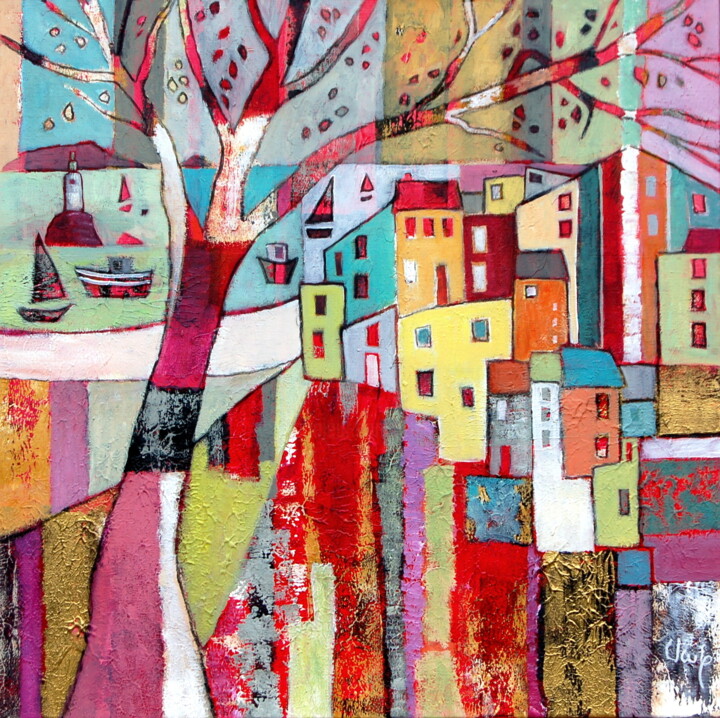
©2024 Claire Biette
Origines et histoire de l’art contemporain
L’histoire de l’art contemporain se déroule au milieu du XXe siècle, marquée par des changements sismiques dans l’expression artistique. Après la Seconde Guerre mondiale, vers les années 1950 et 1960, les artistes ont commencé à expérimenter au-delà des limites traditionnelles, remettant en question les normes de ce que pouvait être l’art. Cette époque révolutionnaire a engendré une multitude de nouveaux mouvements et formes artistiques tels que l’expressionnisme abstrait, le pop art et le minimalisme. Les peintures, autrefois confinées au réalisme, ont embrassé l’abstraction, les artistes utilisant la couleur et la forme pour exprimer des émotions et des idées. Des périodes remarquables comme l’avènement du pop art à la fin des années 1950 et au début des années 1960 ont vu des œuvres d’art imiter la culture populaire et les médias de masse, reflétant le changement de focus de la société.
Les arts sculpturaux ont également connu une métamorphose. Les sculpteurs ont commencé à expérimenter de nouveaux matériaux et formes, créant souvent des œuvres d’art qui interagissent avec le spectateur et l’espace environnant, favorisant un sens de l’engagement. Le dessin, une pratique intemporelle, a également évolué, les artistes incorporant des techniques et des concepts novateurs pour redéfinir son rôle dans l’art contemporain.
La photographie, un médium relativement nouveau, est devenue un outil puissant dans le paysage de l’art contemporain. Née au XIXe siècle, elle a véritablement pris son envol dans la seconde moitié du XXe siècle, brouillant les frontières entre les beaux-arts et la documentation. La gravure, une pratique remontant à l’Antiquité, a connu un intérêt renouvelé et une expérimentation accrue avec des techniques telles que la lithographie, la gravure et la sérigraphie.
L’univers de l’art textile s’est considérablement élargi, car les artistes ont commencé à apprécier la polyvalence et la qualité tactile des tissus et des fibres. Les artistes ont commencé à utiliser les textiles pour remettre en question les frontières entre les beaux-arts, l’artisanat et le design.
L’avènement de la technologie numérique à la fin du XXe siècle a annoncé une nouvelle ère pour l’art contemporain. L’art numérique est apparu alors que les artistes ont commencé à exploiter de nouvelles technologies pour créer des expériences immersives et interactives, brouillant souvent la frontière entre le monde virtuel et le monde physique.
À travers ces périodes de transformation, l’essence de l’art contemporain est restée la même : un reflet dynamique et évolutif de l’époque dans laquelle nous vivons, repoussant continuellement les limites et embrassant le nouveau, remettant toujours en question, toujours explorant.

©2024 Émilie Pauly
Évolutions de ces œuvres contemporaines sur le marché de l’art
Alors que nous naviguons à travers le 21ème siècle, le paysage dynamique de l’art contemporain continue d’évoluer et de s’étendre, reflétant notre monde en constante évolution. Les peintures contemporaines, autrefois principalement confinées à des toiles en deux dimensions, embrassent maintenant une multitude de formes et de techniques, allant des installations multimédias aux créations numériques, chaque pièce étant une riche tissage de pensées, d’émotions et de récits. La sculpture, elle aussi, a largement dépassé la pierre et le bronze traditionnels, les artistes incorporant la lumière, le son et même le mouvement, incarnant l’éphéméralité et le flux du monde moderne.
La photographie, entre les mains d’Artistes Contemporains, a élargi ses horizons, se mêlant parfaitement à la technologie numérique pour créer des images à couper le souffle qui remettent en question notre perception de la réalité. Le dessin, quant à lui, a transcendé les frontières du papier, incorporant des éléments multimédias et des techniques exploratoires pour redéfinir son rôle dans le discours artistique. La gravure continue de prospérer, les artistes contemporains utilisant des méthodes traditionnelles de manière innovante pour fournir des commentaires sociaux et personnels puissants.
L’art textile, autrefois considéré comme un artisanat, occupe désormais une place importante dans le monde de l’art contemporain, les artistes l’utilisant pour explorer les questions d’identité, de tradition et de patrimoine culturel. Pendant ce temps, l’art numérique, le plus récent membre de la famille de l’art contemporain, a révolutionné la façon dont nous créons et interagissons avec l’art, offrant des expériences immersives qui brouillent la frontière entre le virtuel et le physique.
Ces diverses formes d’art contemporain ont une valeur significative sur le marché de l’art actuel, non seulement en raison de leur attrait esthétique mais aussi de leur capacité à encapsuler et à communiquer des idées et des émotions complexes. Les collectionneurs, les conservateurs et les amateurs d’art du monde entier recherchent ces œuvres, attirés par leur dynamisme intrinsèque, leur utilisation innovante des matériaux et leurs expressions éloquentes de notre expérience humaine partagée. En témoignage de notre époque, ces œuvres d’art contemporain encapsulent l’impulsion de notre société et la résonance des voix individuelles, gravant à jamais notre récit collectif dans les annales de l’histoire de l’art.
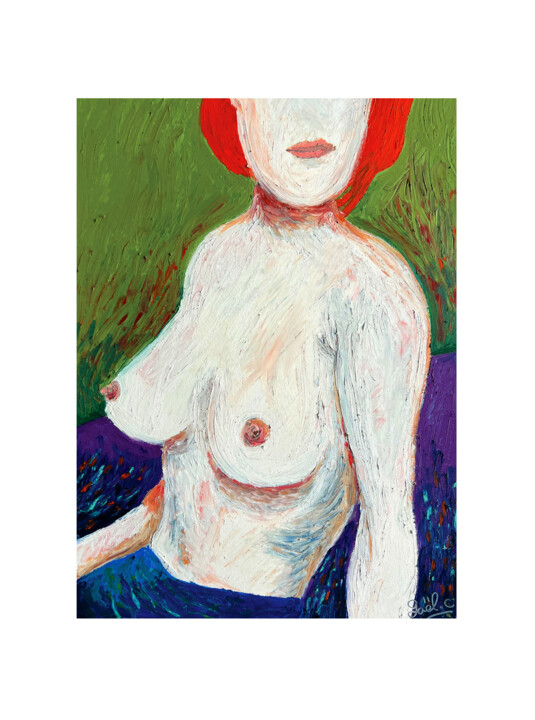
©2024 Gaël Caron
Artistes contemporains célèbres
Alors que nous plongeons dans le monde vibrante de l’art contemporain, nous rencontrons une variété d’artistes qui façonnent ce domaine dynamique. Chacun est un maître dans son médium - peinture, sculpture, photographie, dessin, gravure, textile ou art numérique - ils repoussent les limites artistiques, reflétant notre époque et remettant en question nos perceptions. Explorons ces contributeurs remarquables et leurs œuvres révolutionnaires.
1. Gerhard Richter - Connu pour son approche multifacette de la peinture, Richter défie les limites du médium, oscillant habilement entre les styles abstrait et hyperréaliste. Ses œuvres, qu’elles présentent des pigments étirés à la raclette ou des images photographiques floues, engagent un dialogue fascinant avec la perception.
2. Jeff Koons - Une figure importante de la sculpture contemporaine, Koons crée des pièces monumentales qui explorent les thèmes de la consommation, du goût et de la culture populaire. Ses animaux en ballon iconiques, construits en acier inoxydable poli miroir, captivent par leur commentaire à la fois ludique et profond.
3. Cindy Sherman - Photographe de renom, Sherman utilise son objectif pour explorer l’identité et les rôles sociaux, en particulier ceux des femmes. Reconnue pour ses autoportraits conceptuels, elle assume une multitude de personnages, repoussant les limites de la photographie en tant que moyen d’expression artistique.
4. David Hockney - Hockney, avec une production prolifique s’étendant sur six décennies, est une figure clé du dessin contemporain. Son utilisation audacieuse de la couleur et son exploration ludique de la perspective transmettent un sentiment enivrant de joie et une célébration sans retenue de la vie.
5. Kiki Smith - Une graveuse innovante, le travail de Smith explore la condition humaine, en particulier le corps féminin et ses connotations sociales et culturelles. Ses gravures sur cuivre et lithographies évoquent des expériences universelles de la vie, de la mort et de la transformation.
6. El Anatsui - Maître de l’art textile, Anatsui crée de superbes installations ressemblant à des tapisseries à partir de bouchons de bouteilles et de morceaux d’aluminium jetés. Ces sculptures flexibles et scintillantes mêlent esthétique africaine traditionnelle et sensibilité artistique contemporaine, abordant les thèmes de la consommation, des déchets et de l’interconnectivité de notre monde.
7. Rafael Lozano-Hemmer - Une figure de proue de l’art numérique, Lozano-Hemmer utilise la technologie pour créer des installations interactives qui mêlent architecture et art de la performance. Son travail, souvent participatif, explore les thèmes de la surveillance, de la vie privée et de la relation entre les personnes et leur environnement.

©2024 Seven E
Œuvres d’art contemporain remarquables
Le panorama de l’art contemporain est un patchwork dynamique d’expressions diverses et d’idées innovantes, chaque œuvre étant un dialogue unique avec son public. Voici une sélection d’œuvres d’art contemporain renommées, couvrant divers médias tels que la peinture, la sculpture, la photographie, le dessin, la gravure, l’art textile et l’art numérique, qui ont profondément influencé ce mouvement vibrant.
Ces œuvres, dans leur diversité, illustrent la riche tapisserie de l’art contemporain, chaque pièce étant un commentaire unique sur notre monde et un témoignage du potentiel illimité de l’expression créative.

Seven E
Acrylique sur Papier | 8,7x12,2 in

Irina Afonskaya
Acrylique sur Toile | 19,7x27,6 in
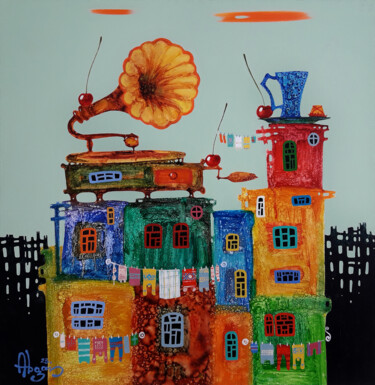
Abgar Khachatryan
Huile sur Toile | 23,6x23,6 in

Émilie Pauly
Acrylique sur Panneau MDF | 27,6x35,4 in
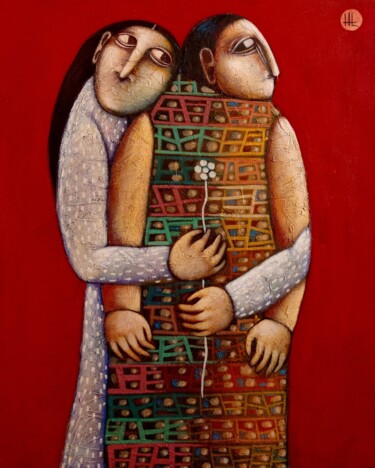
Liana Asatryan
Huile sur Toile | 19,7x15,8 in
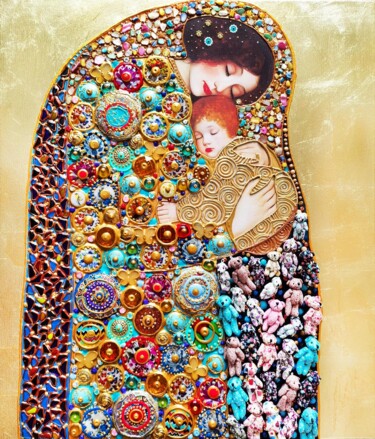
Irina Bast
Mosaïque sur Toile | 27,6x23,6 in
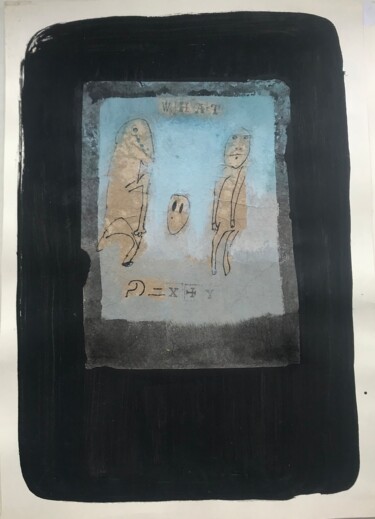
Sergii Shkoliar
Acrylique sur Papier | 16,5x11,8 in
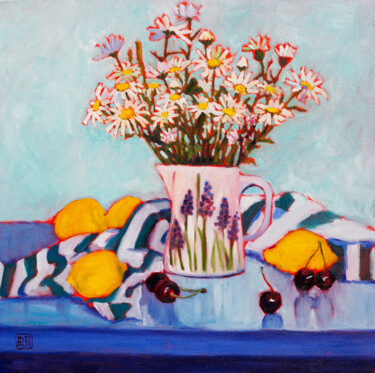
Liudmila Pisliakova
Huile sur Toile | 19,7x19,7 in
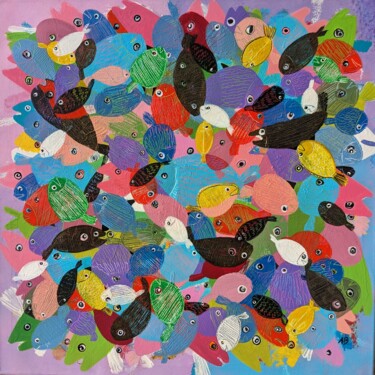
Aude Billerot
Acrylique sur Toile | 23,6x23,6 in

Gaël Caron
Pastel sur Papier | 15,8x11,8 in
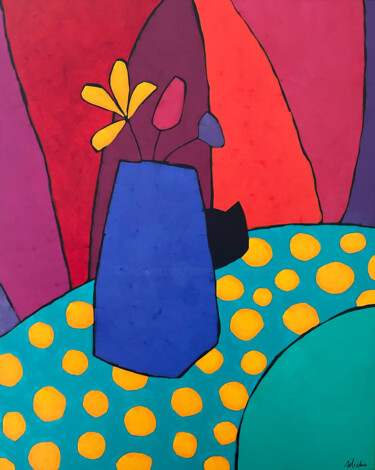
Marie Michaud
Acrylique sur Toile | 30x24 in



